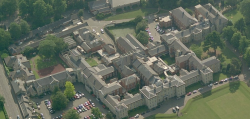Difference between revisions of "Northampton Asylum"
(Created page with "{{infobox institution | name = Northampton Asylum | image = northamptonshire.png | image_size = 250px | alt = | caption = | established = 1836 | construction_began = | construc...") |
m |
||
| Line 28: | Line 28: | ||
As of 2010, St Andrew's Healthcare employs over 3,000 people across the United Kingdom and receives over 95% of its revenue (and patients) from the UK's National Health Service through referrals from NHS Commissioners. St Andrew's has the capacity to cater for around 600 patients across its various sites, but is in a period of rapid expansion and this capacity is likely to increase dramatically over the next few years. As of 2012 the charity has over 1100 beds across 5 sites. | As of 2010, St Andrew's Healthcare employs over 3,000 people across the United Kingdom and receives over 95% of its revenue (and patients) from the UK's National Health Service through referrals from NHS Commissioners. St Andrew's has the capacity to cater for around 600 patients across its various sites, but is in a period of rapid expansion and this capacity is likely to increase dramatically over the next few years. As of 2012 the charity has over 1100 beds across 5 sites. | ||
| − | [[Category: | + | [[Category:Northamptonshire]] |
[[Category:Corridor Plan Institutions]] | [[Category:Corridor Plan Institutions]] | ||
[[Category:Active Institution]] | [[Category:Active Institution]] | ||
Latest revision as of 05:22, 14 May 2014
| Northampton Asylum | |
|---|---|
 | |
| Established | 1836 |
| Opened | 1838 |
| Current Status | Active |
| Building Style | Corridor Plan |
| Location | Northampton, Northamptonshire |
| Alternate Names |
|
History[edit]
The Northampton General Lunatic Asylum opened in 1836 and was funded through local subscriptions. Unlike many other subscription asylums, it did not become a county asylum after the 1845 Lunacy Acts, but was registered as a charitable hospital. This article explores the dynamics that resulted in the Northamptonshire authorities' successfully evading their responsibility to build a county asylum. The loopholes in the supposedly mandatory legislation are examined, with the implications this had for the relationship between the Commissioners in Lunacy and the NGLA governors, as well as the conflict between the local magistrates and the NGLA governors that eventually forced Northamptonshire to conform and build its own specific county asylum in 1876.
As of 2010, St Andrew's Healthcare employs over 3,000 people across the United Kingdom and receives over 95% of its revenue (and patients) from the UK's National Health Service through referrals from NHS Commissioners. St Andrew's has the capacity to cater for around 600 patients across its various sites, but is in a period of rapid expansion and this capacity is likely to increase dramatically over the next few years. As of 2012 the charity has over 1100 beds across 5 sites.